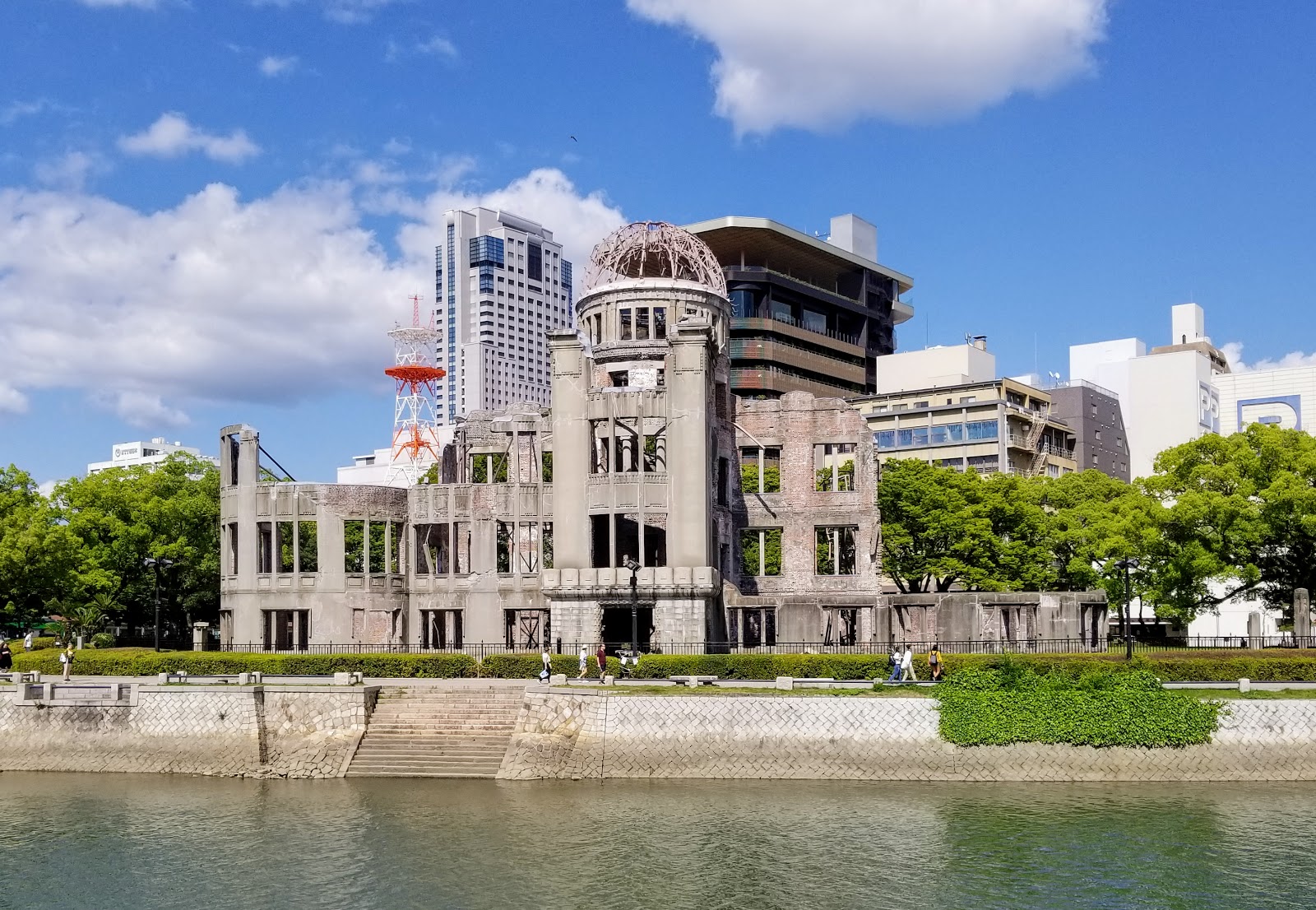Hiroshima
Day 351 (June 14, 2019) – Hiroshima, Japan
Hiroshima requires no introduction. It’s nearly
impossible to forget what happened there as you’re walking around town. Just after arriving, our walk from the bus station to our Airbnb apartment too us right past the Atomic Bomb Dome. As one of the few surviving buildings
from the blast it’s an eerie reminder of what happened. The building used to be
a public exhibition hall but is now just a skeleton of concrete and
brick. Steel beams stick out at strange angles, having been warped by the
intense heat of the atomic bomb explosion 75 years ago.
The Atomic Bomb Dome. Or at least what's left of it.
We spent our first day in Hiroshima visiting the Peace
Memorial Museum and wandering around Peace Memorial Park. The museum was really
well done. There were exhibits on how nuclear weapons were developed, how
Hiroshima was selected by the US military as the first city to be targeted by such a weapon, the events on the day the bomb was dropped in 1945, and the horrible aftermath that stretched on for years for the people who lived there. It was horrific
and distressing, but also eye-opening. The museum and surrounding park ended with
a simple message: don’t let this happen again. We were surprised to discover that
there seemed to be very little animosity towards the United States. Any anger
seemed to be directed more at the act of war itself and at weapons of such incredible destructive power.
A memorial in the park. The top of the Atomic Bomb Dome can be seen in the distance in the center.
The Children's Peace Monument, inspired by the real events written about in the book Sadako and the Thousand Paper Cranes. The glass cases surrounding the monument contain paper cranes that have been folded together to create colorful banners and signs.
After exploring Peace Memorial Park and feeling sufficiently
depressed about world affairs, we had a chance to explore modern day Hiroshima,
which turned out to be a very cool city. Hiroshima gets a lot of character from
the streetcars that zip all around the city. On the roads there is a mix of
newer model trams, which makes the city feel like the modern city that it is, as
well as older model streetcars, which makes you second guess what century you’re
in. It’s an eclectic mix of new and old.
The Hiroshima Peace Memorial Museum.
Hiroshima Castle.
We had also picked up at this point on our trip that our
goal in Japan was not so much to sight see, but rather to eat our way across the
country. We started with one of Hiroshima’s classic diner foods: okonomiyaki. Everything
we read about this dish described it as a savory pancake, but we found that
description to be very misleading. Yes, there is a pancake involved, but it is
so thin and delicate that it does almost nothing for the flavor of the dish and
seems instead to be used as a base to aid in the flipping of this awkward stack
of ingredients. The whole dish is made on a flat grill top. It starts with a thin, round pancake, followed by
layers of cabbage, bean sprouts, scallions, pork, noodles, and a fried egg. It’s
topped with sauce and seaweed flakes. When seated at the counter, the dish was served to us directly on the grill top. We were given a small
metal spatula and told to enjoy. It was a bit difficult to eat at first, but we managed.
Our meal of okonomiyaki.
Hiroshima's okonomiyaki is sort of the Japanese equivalent to an American diner's greasy cheeseburger and fries, served all in one. To be eaten right off the grill top.
Hiroshima is also known for its oysters. I was very
hesitant about oysters. My only real experience with them previously had been
at fancy parties where they were served raw, which I found to be a bit
revolting. But I thought I should give them another try, so we sprang for a
fancy lunch at an oyster bar on the water. We were served a multi-course
lunch consisting of oysters prepared in a half dozen different ways. To my
surprise and pleasure, none were served raw, and I found the whole meal to be exceptionally
delicious. Hiroshima has forever changed my mind about oysters.
The first course of our oyster lunch.
The second course with a side of oyster rice. This meal forever changed my mind about oysters for the better.
We also took a day to explore the sake breweries in the nearby
town of Saijo. The tourist information office at the train station provided us
with a map of the small town and a suggested walking route to take us past a number
of local breweries. We stopped by as many as we could, and we learned all about
how sake is made. We also had a chance to sample different kinds. Prior to this
trip I don’t think I appreciated the diversity of sake. Some were sweet, others
dry, and the alcohol content also varied considerably. Some of them were even
carbonated. We bought a couple small bottles of our favorites to take home with
us. It was a fun afternoon trip from Hiroshima.
A sake brewery in Saijo.
The train ride out to Saijo from Hiroshima was itself an enjoyable experience too.
We ended our time in Hiroshima by sharing a small bottle
of sake and going out for dinner at another conveyor belt sushi restaurant. It
was a nice ending to an excellent stop on our trip. The next day we were going
to be catching a bus further north to Kyoto.
Another delicious and inexpensive meal of conveyor belt sushi.















Comments
Post a Comment